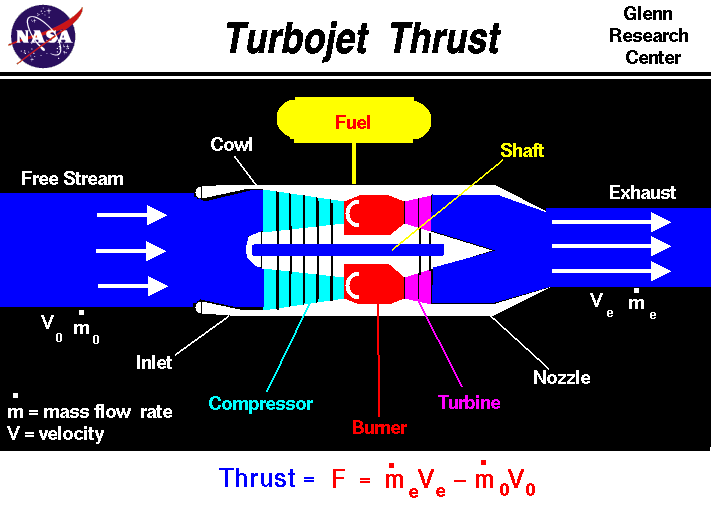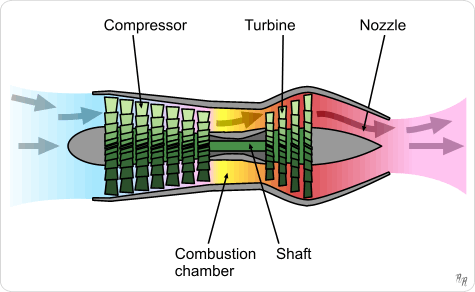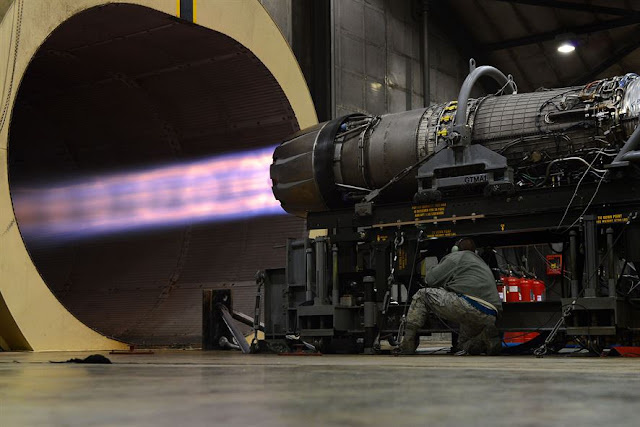bang
blow
combustor
compressor
diffuser
lift
lift equation
mass flow rate
nozzle
squeeze
suck
Thrust
Turbojet Engine.
velocity
What is aircraft thrust?
What is aircraft thrust?
Now how is a body that heavy going to be able to propel itself to achieve lift?
A little background check on the little devil that decide how fast this man-made birdie can move...
What is Thrust?
Thrust: The holy matrimony of the Pressure formula and Force equilibrium gave birth to this simplified formula for thrust.
 |
| Here the mass flow exiting the engine is the sum of the mass flow rate of air and the mass flow rate of fuel(added at the burner). But since this mass flow rate of fuel is relatively small, we will ignore the term in our simplified equation. |
T = Ma(Ve-Vi)
From this, the science humans found that thrust is directly proportional to :
1.mass flow rate of air (mass of air flowing per unit time...we like bringing time into the picture when we work with a flow in motion aka fluid dynamics, in another article we’ll tell you why)
2. the velocity difference between the entrance to the engine and the exit of the engine. (The thrust equation is derived considering the engine as the isolated system)
It doesn’t take a rocket scientist to know that if we increase one of the two or both of them were going to get what we want. WHAT DO WE WANT? THRUST! WHEN DO WE WANT IT? NOW!
How do we achieve in increasing one or more of these two quantities?
Suck. Squeeze. Bang. Blow.
 |
| Heinkel 178, Pleasure to meet you. |
Imagine a Heinkel 178 cruising in the air on a late August morning over the greenest fields of 1939 Germany. The test pilot Erich warsitz sits in his cockpit not knowing that he would go down in history as the first man to fly an aircraft powered by a turbojet engine. The gas turbine engine was a man-made marvel and took on the world war by a storm, putting its piston predecessor to shame.
Sounds radical doesn’t it, but what really happens on the inside?
There’s nothing left to do but to march through the engine, one component at a time.
 |
| Just your average jet engine. |
Suck: The diffuser is a welcome mat to the engine. It’s job? To reduce the velocity of the incoming air. Why? Because slower air is easily tamed by the components following it. How does it do this? It’s a diverging section by geometry. The continuity equation would tell you that area and velocity are inversely proportional. So when the area increases in the section, velocity will decrease creating a slower flow.
This doesn’t really sound like a sucking mechanism does it? Well, the sucking happens because of a pressure difference. You see a flow is established when there is a difference in pressure. High pressure to low pressure: that’s all the navigation that fluid particles comprehend. (Why? In the microscale all atoms look to settle in a place of a lower energy, lower pressure means it has lower internal energy associated with it)So in order to suck in the air, the diffuser must be at a lower pressure level than the atmospheric pressure of free stream outside. How do you make this happen? By geometry. The more the wall of the diffuser diverges, the more the air that sticks to its boundary begins to feel like it’s not wanted anymore (nobody likes a clingy neighbour...get the hint bob)
So the wall is put at an angle such that, at a distance from the diffuser inlet, the flow separates from the boundary swirling inwards and making a low-pressure region there. This low pressure pulls the higher pressure free stream towards it and they make sweet sweet love. Thus generating a flow.
Squeeze: the second is the compressor. It’s job? To increase the pressure of the air (compress) how does it achieve this? It’s composed of a series of rotating and static blades called rotor and stator. The energy equation (Bernoulli equation) tells us that the sum of pressure head, kinetic head, and a gravitational head is a constant.
Or energy is conserved. The rotor creates velocity increase (by virtue of its rotation) and this translates to a pressure increase at the stator, satisfying the conservation of energy. Moral: to properly satisfy, one must properly squeeze.
Bang: Thirdly comes the combustor. The slow squeezed air comes into the combustor hoping to get hot. Combustor’s job? To create kinetic energy increase. When fuel and air are mixed and set on fire by a spark plug, this results in a massive increase in kinetic energy. (And temperature duh) how does this kinetic energy increase? Fuel and air mixing and being set on fire is a chemical reaction. So this chemical energy is going to be converted into kinetic energy. This hot faster-moving gas goes on to the next component: Turbine. The Siamese twin of the compressor with regards to mechanical parts does the exact opposite of what the compressor does, decreasing the pressure.
Hot fact: The turbine and the compressor are Siamese twins in another aspect. They’re joined at the hip. A shaft connects the turbine to the compressor driving it.
Wait, what?
This would mean that once a sustained flow is established in the engine, the turbine and the compressor work in synergy: driving each other. That’s exactly what happens. The kinetic energy produced in the combustor is what really produces the propulsive thrust. Without the combustor, it would just be a sustained operation of a compressor turbine system. And without the compressor turbine system, the engine would only be an uncontrolled explosion courtesy of the combustor. Hot damn.
Blow: the exhaust is a nozzle which implies that it is a converging geometry. It increases the velocity by the same principle employed at the diffuser. The faster air is expelled through the nozzle thus increasing the difference in velocity portion of the thrust formula. How do we increase the mass flow rate? In a turbofan configuration, there is a portion of air which is allowed to pass along the side of the engine, not through the various components: bypassing it. Kinda like a get out of jail free card, you don’t need to be sucked squeezed banged and blew, to be a reliable contributor to the system. Or so my mother tells me.
Now addressing the question that was posted. How does this help with a lift?
| Lift formula |
The formula for lift shows that lift and the forward velocity are like two peas in a pod, one increased, the other does too. When thrust increases, the forward velocity increases...which leads to the increase in lift. (It should be noted that you must increase the other parameters of area and angle of attack to attain enough lift to take off ). That's exactly why you see aircrafts taking a running start before they lift off from the runway.
And now you know how to get 900 whale testicles to take flight.
Thanks for reading!






